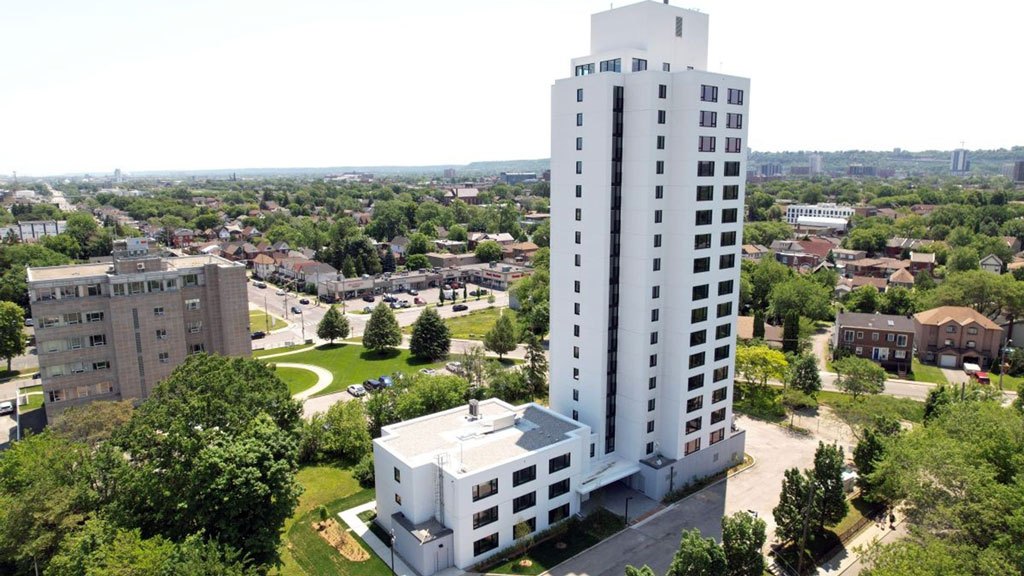A new cladding system is providing a non-combustible solution to make new and older buildings safer, sustainable and more resilient.
The PUCCS non-combustible exterior insulated finish system (EIFS) by DuROCK Alfacing International Ltd. was selected as the first-place winner of this year’s Toronto Construction Association (TCA) Innovative Product Award.
The Vaughan, Ont.-based company is a family-owned EIFS manufacturer that has been around since 1979.
Over 15 years ago they came out with the PUCCS system, which was innovative at the time, explained Andre Turrin, technical director with DuROCK Alfacing International Limited.
The newest innovation of the technology, PUCCS NC, was released in December 2018. There is one distinct difference between the two — one is combustible and the other is non-combustible.
“From a codes perspective, as far as the cladding is concerned, the two systems perform all of the same functions with the exception of fire resistance,” said Turrin.
“Any EIFS system that includes the polystyrene insulation is combustible cladding. Our new system with the PUCC-ROCK mineral wool insulation is non-combustible cladding.”
While both systems have a Geometrically Defined Drainage Cavity (GDDC), the original system uses a combustible polystyrene foam insulation, whereas the new system incorporates the GDDC into non-combustible PUCC-ROCK mineral wool insulation.
“They are both drained assemblies incorporating that GDDC but the innovation was to do that in the mineral wool insulation as opposed to the polystyrene insulation which has been the work horse for the EIFS industry since its inception many years ago.”
Both systems also have a liquid-applied, water-resistive barrier.
“An outboard air/water barrier makes achieving greater air-tightness for our buildings much easier,” states the submission to the TCA. “These qualities also contribute better construction detailing and to building more resilient homes.”
The vast majority of EIFS installed in Canada are combustible, however recent facade fires on highrise buildings in various parts of the world have drawn attention to the use of combustible cladding and combustible insulation on the exterior of those buildings, Turrin explained.
“That’s why we decided to develop this particular system,” he noted. “There is more work involved in working with the non-combustible insulation but of course it has its benefits and particular uses it is well suited for, where either the codes prescribe its use or people just want to use it in place of the standard system,” he said.
Mineral wool is difficult to cut and it has a much lower cohesive strength than polystyrene.
“Polystyrene insulation is a foam plastic, a relatively soft material,” Turrin explained. “It’s quite easy to cut a grooved air space or drainage cavity into the backside of it but when you look at mineral wool insulation which is made from rock and slag it is considerably more difficult to cut a drainage cavity into its backside.”
The system complies with the Ontario Building Code and the National Building Code of Canada. It can be used for reduced side and rear yard applications where the Ontario Building Code requires a non-combustible cladding.
The product has huge potential in the retrofit market, Turrin said.
There are many buildings across Toronto and Canada that are in dire need of insulation to reduce their GHG emissions and to help make them both sustainable and resilient.
“When it comes to retrofits, many building owners are opting for this system because of the peace of mind it affords them not because they are required to use it by code. They choose to use it,” said Turrin.
“We have an aging stock of buildings that are in dire need of energy upgrades. This new system of ours will go a long way to helping those buildings achieve those requirements.”
As an example, the system was used in the retrofit of the Ken Soble Tower, an 18-storey purpose-built seniors’ rental apartment in Hamilton, Ont. The building had a deteriorating envelope, lack of insulation, inadequate ventilation and lack of thermal controls and the goal was to achieve EnerPHit certification, a branch of the Passive House Standard and reduce carbon emissions.
To meet the growing demand for the technology, a new facility was needed to produce up to 2000 PUCC-ROCK boards per day. The company had to design and purchase two cutting machines, build a meshing machine by manufacturing parts in-house, build a conveyor system to move product throughout the manufacturing facility, build curing ovens, install dust collection systems and design and install a packaging system, the submission states.
Follow the author on Twitter @DCN_Angela.








Recent Comments